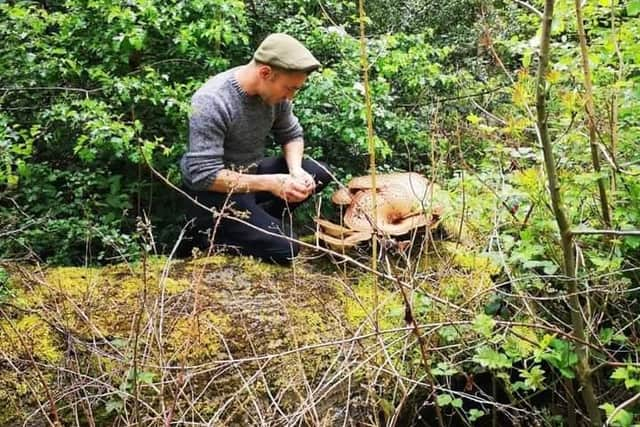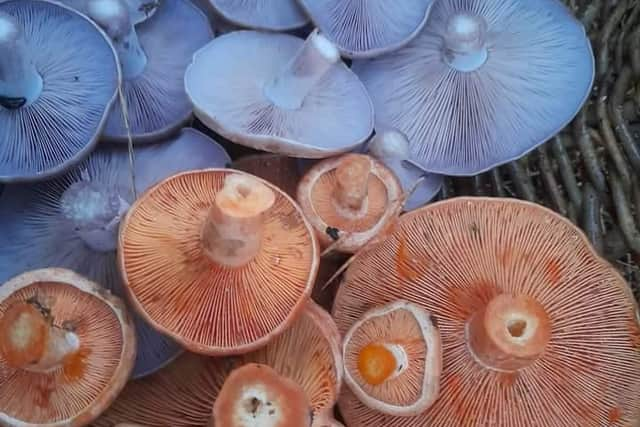Foraging company, Wee Folk of the Woods, was started up for health reasons, but now supplies The Kitchin
and live on Freeview channel 276
“We started foraging a few years ago as a hobby,” says Lindsey Laing, 40. “However, when Gerard was diagnosed with a rare autoimmune disease about two years ago we decided he should take it up full time as the stress of his sales job was making his condition worse”.
Gerard Murphy 43, who has a line drawing of chanterelles tattooed on his forearm, suffers from mucus membrane pemphigoid. When he was first diagnosed, the couple were worried that he might lose his sight.
Advertisement
Hide AdAdvertisement
Hide Ad“He is one of only a couple of people in Scotland that has the disease,” says Lindsey. “It basically means his body attacks the cells in his eyes, nose and throat”.
The result of the career switch, which has worked to lower Gerard’s stress levels, is foraging company, Wee Folk of the Woods, who supply restaurants as well as offering foraging courses. A picture of some of their wares - “first of the season” St George’s - were recently posted to The Kitchin’s Instagram account, with head chef, Lachlan Archibald, holding a basket that’s packed full of pale mushrooms.
“It’s great to be recognised by our customers for the produce we give them,” says Lindsey, who works full time, but helps Gerard on evenings and weekends, along with their nine-year-old rescue staffie, Millie. “The Kitchin is our main customer but we do have other restaurants, wholesalers and shops”.
The St George’s mushrooms, with a consignment also going to Castle Game Scotland as an ingredient in wild boar sausages, are currently in demand, especially as they’re abundant after a drought last year. These spring fungi are named as they usually first appear on St George’s Day (April 23), and taste cucumber-y, earthy and mealy.
Advertisement
Hide AdAdvertisement
Hide AdLindsey explains that they also tend to pick up plenty of orders for wild garlic and spring plants.


However, these advanced foragers are not just into the more obvious finds, like chanterelles, sea buckthorn and the occasional pignut. They’ve also harvested the mottled mushroom that is dryad’s saddle (or pheasant’s back), wood blewits, saffron milk cap, few-flowered leek seeds, sea sandwort, hogweed shoots, cuckoo flower, which they say tastes like wasabi, and the “superfood gold dust” that is pine pollen, which is infused in honey to go on porridge.
Although the couple are based in Falkirk, they forage in “all sorts of natural habitats, but mainly in central Scotland”.
“Our favourite discovery is a mushroom that we are currently awaiting being identified, though it’s believed that it may be a rare (in Scotland) silky rosegill or indeed a new species”, says Lindsey. “We have a mycologist friend who is identifying the mushroom for us. It’s been in deep freeze to preserve it since lockdown started, so we are really excited to find out if it is a new species now that restrictions are starting to ease and it can be tested”.
Advertisement
Hide AdAdvertisement
Hide AdWhile they wait to find out, they’re happy to share their expertise.


“We enjoy teaching people what we know, as passing on knowledge helps foraging stay alive,” says Lindsey. “It’s so rewarding seeing the look on people’s faces when they find out they can eat something they walk past every day”.
A message from the Editor:
Thank you for reading this article. We're more reliant on your support than ever as the shift in consumer habits brought about by coronavirus impacts our advertisers.
If you haven't already, please consider supporting our trusted, fact-checked journalism by taking out a digital subscription.
Comment Guidelines
National World encourages reader discussion on our stories. User feedback, insights and back-and-forth exchanges add a rich layer of context to reporting. Please review our Community Guidelines before commenting.